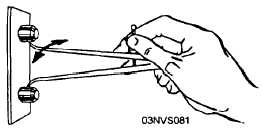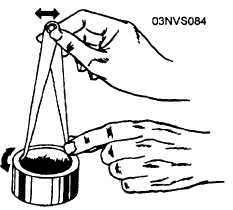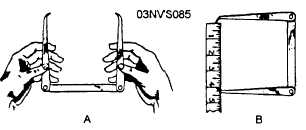Figure 2-11.- Measuring the distance between two surfaces
with an inside caliper.
Measuring Hard-to-Reach
Dimensions
To measure an almost inaccessible outside
dimension, such as the thickness of the bottom of a cup,
use an outside transfer firm-joint caliper as shown in
figure 2-12. When the proper “feel” is obtained, tighten
the lock joint. Then, loosen the binding nut and open
the caliper enough to remove it from the cup. Close the
caliper again and tighten the binding nut to seat in the
slot at the end of the auxiliary arm. The caliper is now
at the original setting, representing the thickness of the
bottom of the cup. The caliper setting can now be
measured with a rule.
To measure a hard-to-reach inside dimension, such
as the internal groove shown in figure 2-13, use an
inside transfer firm-joint caliper. Use the procedure for
measuring a hard-to-reach outside dimension.
Measuring Hole Diameters
To measure the diameter of a hole with an inside
caliper, hold the caliper with one leg in contact with
one side of the hole (fig. 2-14) and, as you increase the
setting, move the other leg from left to right, and in and
out of the hole. When you have found the point of
largest diameter, remove the caliper and measure the
aliper setting with a rule.
A
03 NVSO82
B
Figure 2-12.—Mcasuring the thickness of the bottom of a
cup.
Figure 2-13.-Measuring a hard-to-reach inside dimension
with an inside caliper.
Figure 2-14.—Measuring an inside diameter with an inside
caliper.
Setting a Combination
Firm-Joint Caliper
To set a combination firm-joint caliper with a rule,
when the legs are in position for outside measurements,
grasp the caliper with both hands as shown in view A
of figure 2-15, and adjust both legs to the approximate
setting. After you adjust both legs, the shape of the tool
will be approximately symmetrical. Thus, it will
maintain its balance and be easier to handle.
Check this approximate setting as shown in figure
2-15, view B. Sight squarely across the leg at the
graduations on the rule to get the exact setting required.
Figure 2-15.—Setting a combination firm-joint caliper.
2-6











